Mud logging, in its conventional implementation, involves the rig-site monitoring and assessment of information that comes to the surface while drilling, with the exclusion of data from downhole sensors. The term mud logging is thought, by some, to be outdated and not sufficiently descriptive. Because of the relatively broad range of services performed by the geologists, engineers, and technicians traditionally called mud loggers, the term “surface logging” is sometimes used, and the personnel performing the services may be called surface-logging specialists. Additional specialist designations may include:
· Pore pressure engineer
· Formation evaluation engineer
· Logging geologist
· Logging engineer
For the sake of generality, the terms mud logging and mud logger are used here with the understanding that the hybrid discipline encompasses much more than monitoring the mud returns and that the trained specialists perform engineering and geological tasks that span several traditional disciplines.
Objectives of mud logging
There are several broad objectives targeted by mud logging: identify potentially productive hydrocarbon-bearing formations, identify marker or correlatable geological formations, and provide data to the driller that enables safe and economically optimized operations. The actions performed to accomplish these objectives include the following:
· Collecting drill cuttings.
· Describing the cuttings (type of minerals present).
· Interpreting the described cuttings (lithology).
· Estimating properties such as porosity and permeability of the drilled formation.
· Maintaining and monitoring drilling-related and safety-related sensing equipment.
· Estimating the pore pressure of the drilled formation.
· Collecting, monitoring, and evaluating hydrocarbons released from the drilled formations.
· Assessing the producibility of hydrocarbon-bearing formations.
· Maintaining a record of drilling parameters.
Mud logging service first focused on monitoring the drilling mud returns qualitatively for oil and gas content. [1][2] This included watching the mud returns for oil sheen, monitoring the gas evolving from the mud as it depressured at the surface, and examining the drill cuttings to determine the rock type that had been drilled, as well as looking for indication of oil on the cuttings. Detection of the onset of abnormal formation pressures using drilling parameters was proposed with the introduction of the d exponent. [3] Gas chromatography, which was developed early in the 20th century, saw its introduction in mud logging in the 1970s when electronics became sufficiently compact, rugged, and robust to be used at rig sites. The literature provides excellent reviews of the early history. [4][5]
Computerized data acquisition and the ability to routinely transfer continuously acquired data to the office data center enabled the broader application of more sophisticated interpretive techniques and the integration of data from different sources into the geological and reservoir model, in near real time. This, coupled with the blossoming of measurement-while-drilling (MWD) and logging-while-drilling (LWD) tools, moved the mud-logging unit into a new role as a hub for rig-site data gathering and transmission. Starting in the 1980s, significant improvements to existing technologies, as well as major technical breakthroughs, have given the geologist and petroleum engineer a great number of powerful mud-logging tools to interpret and integrate geological, drilling, and geochemical data. These tools are discussed in subsequent sections of this chapter.
The traditional products delivered by a mud-logging vendor include:
· Geological evaluation
· Petrophysical/reservoir formation evaluation
· Drilling engineering support services
In this overview, we consider that these products support three basic processes associated with drilling and evaluation of wells:
· Formation evaluation (building or refining the geological and reservoir models)
· Drilling engineering and operations (the planning and execution of the well construction process)
· Maintaining drilling and evaluation operations with appropriate health, safety, and environmental (HSE) consideration
Mud logging data acquisition
Fig. 1 schematically shows the components of a drilling operation that have a part in mud logging. The most critical component is the drilling fluid (drilling mud), which, in addition to its role in drilling mechanics, carries most of the information from the formation up to the surface where it is acquired, decoded, or extracted from the mud stream by various techniques. Drilling liberates gas and liquid formation fluids, and circulation of the drilling fluid carries these to the surface (except during riserless drilling in a deepwater offshore environment, in which the drilling returns circulate only up to the sea floor). Cuttings, pieces of formation rock, are also carried in the circulated drilling fluid. MWD and LWD data are frequently encoded as pressure pulses and transmitted to the surface. Mud temperature is not a direct indicator of subsurface formation temperature, but monitoring the trend is important to understanding gas extraction efficiency and recycling. In deepwater drilling environments, the mud can be cooled significantly on the trip from the sea floor to the surface.

Fig. 1 – Drilling fluid flow path during drilling operations.
Drilling fluid is stored in the mud pit, drawn into the mud pumps, and pumped into the drillpipe via the kelly. Mud travels down the drillpipe, through any MWD tools and drill motors, and through the bit nozzles where its discharge aids drilling mechanics. At this point, the drilling fluid carries away rock fragments from drilled formation, along with any liberated reservoir fluids (water, oil, or gas). Cuttings and reservoir fluids are transported to the surface. Any gaseous components are dissolved in the base fluid of the drilling mud under most overbalanced drilling conditions. Drilling mud continues its flow up the wellbore drillstring annulus, through the casing-drillpipe annulus and the blowout preventer (BOP) stack, and, in the case of an offshore well, up the riser. At the bell nipple, the returning drill fluid is exposed to atmospheric pressure and flows down the mud return line. If an underbalanced drilling operation is being used, there is a rotating seal around the drillpipe, and the pressurized drilling returns stream moves through the “blooey line” to a separator and flair.
The return mud stream continues down the return line to the shaker box or “possum belly.” This is the standard location for the “gas trap” gas extractor. Mud pours over the shaker screens, with cuttings getting discharged off the top of the screen, while the drilling fluid that falls through the screens travels on through the degasser, desander, and desilter to the mud pits. The mud logger takes samples or acquires data at the following points in the process:
· Whole mud samples are taken at the mud suction pit and at the possum belly and are used to do whole-mud extraction using a steam still. They may be taken on an occasional basis during coring and wireline logging to assess the effects of mud filtrate and solids.
· Drill cuttings samples are taken off the shaker screen and off a “catch board” where cuttings fall from the screen to disposal. These are used for lithological and mineralogical description, paleo description, and sometimes “canned” for laboratory-based carbon-isotope analysis, detailed geological examinations such as thin-section preparation and analysis, chemostratigraphy, and source rock evaluation.
· Gas sampling is done through an extractor at the possum belly, in some cases at the bell nipple or off the mud return line to minimize losses to the atmosphere, and at the mud suction line or mud pit to monitor recycle gas content of the mud. After extraction, gas analysis may be performed at the sampling location, [6] or, more routinely, the gas is continuously transferred via a vacuum line to the logging unit where it is passes through the manifold of analytical instruments (total HC, GC, MS, H2S, etc) and may be captured for laboratory-based analysis (carbon isotope, molecular composition). [7]
· Mud temperatures are monitored at the mud suction pit and mud return line.
The mud engineer collects mud samples for analyses that are used to determine any adjustments to mud properties needed for drilling.
Contamination is defined here as any material that does not come from the formation that has been drilled at the time that a specific volume element of mud exits the bit. Mud contamination has several potential sources:
· Air, which can enter the top of the drillpipe when the Kelly-drillpipe joint is broken during a connection.
· Pipe scale and pipe dope from inside the drillpipe (pipe dope fluoresces and may interfer with show identification or description).
· Rock sloughing or rubbing off formations further up hole.
· Cuttings that have bedded or built up because of improper hole cleaning dynamics that are mobilized by changes in mud viscosity, pumping rate, or drillpipe or collar rotation.
· Uphole fluids that flow or are swabbed into the annulus.
· Cuttings that have built up on the shaker screen or in the possum belly.
The logger should be watching for any change in cuttings or mud-conveyed hydrocarbon fluids that indicate contamination. Mud additives such as weighting agents and lost-circulation material are not considered contaminants, but must be monitored because some of these interfere with analytical observations and descriptions or give interfering instrument responses. Some base mud fluids, particularly some of the synthetic fluids, create challenges for the mud logger, as do some chemical additives (e.g., some sulfate or sulfonate wetting agents may give a false positive H2S indication).
Samples of the drill cuttings are taken at the shale shaker. Wellsite geologists or engineers should specify the appropriate procedure for collecting samples, which may be done by the mud logger or the mud logger’s sample catcher. Cuttings have a relatively short residence time on the shaker screen. Sampling protocol should include taking a composite sample with portions from different areas of the screen, combined with cuttings that have been retained on a “cuttings board.” A cuttings board is a wooden board, steel angle iron, or other such device that is hung just below the base of the shaker screens to catch cuttings as they fall off the edge of the screen. Immediately after samples are collected, the screen and catch board should be washed down with clean drilling mud base fluid. The logger should mix this composite sample and take divided portions for cleaning, interpretation, and bagging. The wellsite planner should specify the sampling frequency (typically a composite over 10-, 30-, or 90-ft intervals or on a timed basis).
Gas sampling is traditionally done with a mechanical degasser, generically called a “gas trap.” Fig. 2 shows an example. [8] Typically placed in the shaker box, the trap pulls in drilling mud through the centrifugal action of the stirrer. The mechanical action of the stirrer, combined with a slight vacuum pulled in the trap head space, allows the gas to partition between the liquid and gas phase. The head-space gas is pulled by vacuum through tubing, into the logging unit, and on through the gas analysis manifold.

Fig. 2 – Schematic of a gas-trap type gas extractor.
Alternative methods for sampling gas may be accomplished by continuously operating controlled-volume mechanical or thermomechanical slip-stream gas extractors and membrane-type extractors. The mud logger may place the sampling point for these gas extraction devices at the bell nipple, the mud return line, or in the shaker box. Other methods require taking discrete samples, followed by thermal extraction techniques [such as the steam still, where samples of the whole mud are collected and portions heated in a steam-distillation apparatus (Fig. 3)] and microwave heating methods.

Fig. 3 – Schematic of a steam still-gas extractor.
The gas manifold may include provisions for a portion of the gas stream to be pumped into sample containers, either laminated gas bags or stainless steel tubes. [Personal communication with D. Coleman, IsoTech Laboratories, Champaign, Illinois (2002)] (see Fig. 4). These gas samples are then shipped from the rig for laboratory analyses. There are new mass-spectrometer-based techniques that may not require a bulk extraction of the gas from the mud for analysis.

Fig. 4 – Low-pressure gas sampling tubes mounted two to a rack for continuous, sequential gas collection.
Once gas is extracted from the drilling fluid, various analytical techniques determine properties of the gas at the rig site. The basic measurements include a determination of the “total” gas concentration and the composition and concentrations of the constituent components.
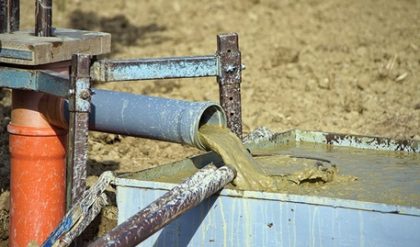
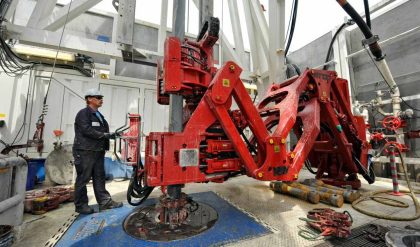
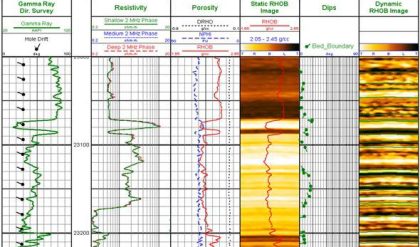

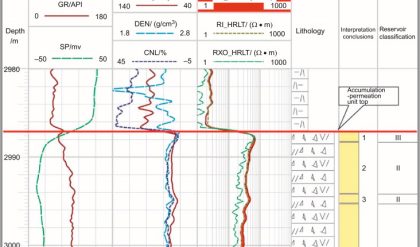
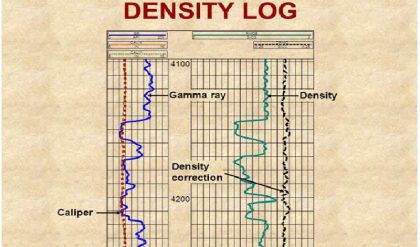
Comments are closed.